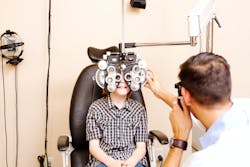Sickle cell disease is a rare, inherited disorder in which the red blood cells become hard, sticky, and change shape, resembling the farm tool. People who have it can sometimes develop vision problems when these sickle-shaped cells get trapped in the small blood vessels as the back of the eye.
Sickle retinopathy is an age-dependent process, with older people being at substantially higher risk, than younger patients. To learn more about how this condition manifests in children, researchers at the University of Tennessee Health Science Center conducted a large, retrospective review at their institution. What they found surprised them. One in three children had retinopathy, of which 9 percent required treatment, suggesting children need to be screened for vision problems as often as adults with sickle cell disease. The study was presented at AAO 2023, the 127th annual meeting of the American Academy of Ophthalmology.
To conduct the study, they evaluated records for 652 patients, aged 10 to 25 years (median age: 14) who underwent eye exams (2,240 visits) over a 12-year period. They found:
- 33 percent had nonproliferative retinopathy (NPR)
- 6 percent had proliferative retinopathy (PR).
- 33 eyes were treated with panretinal photocoagulation, most commonly for PR stage 3 (43 percent). Intravitreal anti-VEGF therapy was given to five eyes, all with PR.
- Other complications included retinal detachment and retinal artery occlusion in two patients each.
- Vision loss (final best corrected visual acuity 20/60) following complications from sickle cell disease was noted in only one patient with a central retinal artery occlusion.
American Academy of Ophthalmology release on Newswise

